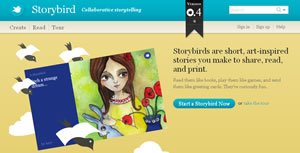A colleague has recently put me onto a rather whizzy website called Storybird. What is Storybird? According to Storybird the central idea is that ‘making stories can be social, fun and easy’ so they have provided a bank of images which you can choose to write and publish on-line your very own picture books. And it is all free and simple to use!
I see this fitting in rather nicely to the National Strategy’s Progression Strand 10, Exploring and analysing language. I have seen the analysis of children’s picture books taught very effectively at Key Stage 3 before and what better way to get students actively involved than to demonstrate their understanding of the linguistic techniques used in picture books by writing their own? Students could easily create and save their own Storybird picture book in a lesson and then in a subsequent lesson they could present their stories to the class, explaining their linguistic choices (Speaking & Listening AF1) or take part in a group discussion where they analyse another student’s story (Speaking & Listening AF2).
Naomi Hursthouse
Advance Skills Teacher
Steyning Grammar School



